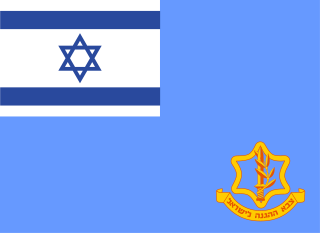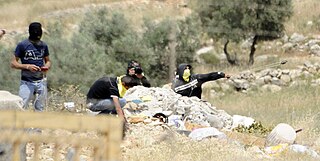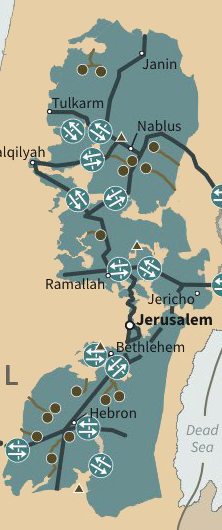Israeli occupation, 1967–present
In the West Bank both the British Mandatory "Defense Emergency Regulations of 1945, No. 88" – stipulating that "every article, picture, advertisement, decree and death notice must be submitted to military censors", – and "Israeli Military Order No. IOI (1967)", amended by "Order No. 718 (1977)" and "No. 938 (1981)" concerning "the prohibition of incitement and adverse propaganda" formed the basis for censoring West Bank publications, poetry and literary productions. The problem was that no guidelines clarified precisely what could or could not be said, and even articles translated directly from the Hebrew press could be prohibited, or love poems free of any nationalistic undertone could be suppressed from publication by a censor, or theatrical pieces approved in Israel could be blocked by arbitrary fiat by any military governor, or staging denied by simply not replying to requests for permission. Newspapers could lose their licenses, without any reason given, on the basis of 1945 Emergency Regulation (Article 92/2). There were two distinct censorship bureaus, one run by the military and the other by the civil administration, and what was allowed by one could be overturned by the other, and this double procedure applied to galley proofs of every article in newspapers. In the first decades of occupation, Palestinian publications were vetted and numerous books were censored to remove any phrase or expression which was considered as "incitement" or fostering national feelings among the Palestinians. Thus even obituaries stating that a family "in the homeland and the diaspora mourns" the deceased was struck out. Coverage of Israel's 1982 invasion of Lebanon in Jerusalem's Arabic papers, and particularly condolence notices, were severely curtailed. The word "pride" used in an obituary for the fallen was objected to. Editors were harassed and papers closed for containing articles critical of settlements.
Censorship even extended to denying travel permits for notable Palestinians like Elias Freij, Major of Bethlehem, scheduled to be interviewed in the US on NBC's Meet the Press. That war, according to several Israeli observers like Ze'ev Schiff, Yehoshafat Harkabi and Avner Yaniv, was itself strategically motivated as necessary to "safeguard the occupation of the West Bank." When Yitzhak Laor appealed to the Israeli Supreme Court about the way the censorship board censored his play – which made analogies between the military government in the territory and Nazism, the Court backed the plaintiff, leading to the board's suspension. The court's decision had no effect on the military's censorship body in the West Bank and Gaza, and plays can be closed if it is thought their content threatens Israel's security. Graffiti (shi'arati) are a major medium for protesting occupation and flourished under the First Intifada. They were illegal by the fact that they were written without obtaining a permit. Julie Peteet states that "it was illegal to write for public dissemination without submission of the text to the censors". Under Military Order 1260 promulgated in November 1988, Israeli military authorities could fine $350 the owner of any property on whose walls the graffiti artist had written a slogan or painted a picture. This proved to be so lucrative a source of revenue for the Israelis that the intifada authorities themselves had to prohibit the practice. [lower-alpha 1] Soldiers blacked out or scrubbed walls of graffiti, or when incised, had them chiselled off: when book-long collections of such graffiti were published, they were banned by the military censor. Even works unrelated to the conflict have been banned in the occupied territories, as was Hamlet. Fathi Ghabin received a 6-month gaol sentence for using the PLO colours – red, black, green, and white – in one of his paintings.

The West Bank, so called due to its relation to the Jordan River, is the larger of the two Palestinian territories. A landlocked territory near the coast of the Mediterranean Sea in the Levant region of West Asia, it is bordered by Jordan and the Dead Sea to the east and by Israel to the south, west, and north. The territory has been under Israeli occupation since 1967.

Ramallah is a Palestinian city in the central West Bank or Ramallah Bank, that serves as the de facto administrative capital of the State of Palestine. It is situated on the Judaean Mountains, 10 km north of Jerusalem, at an average elevation of 872 meters (2,861 ft) above sea level, adjacent to al-Bireh.

The First Intifada, also known as the First Palestinian Intifada or the Stone Intifada, was a sustained series of protests, acts of civil disobedience and riots carried out by Palestinians in the Israeli-occupied Palestinian territories and Israel. It was motivated by collective Palestinian frustration over Israel's military occupation of the West Bank and the Gaza Strip, as it approached a twenty-year mark, having begun in the wake of the 1967 Arab–Israeli War. The uprising lasted from December 1987 until the Madrid Conference of 1991, though some date its conclusion to 1993, with the signing of the Oslo Accords.
The Editors Committee is an informal forum comprising the editors and owners of the main Israeli media. It meets regularly with the prime minister, cabinet members and senior officials. Until the 1980s, it took a central role in the self-censorship practiced by the Israeli media. The understanding was that the information reported to the committee would not be published in the media, even once received from another source.

Norman Gary Finkelstein is an American political scientist and activist. His primary fields of research are the politics of the Holocaust and the Israeli–Palestinian conflict.

'Ayn Ghazal was a Palestinian Arab village located 21 kilometers (13 mi) south of Haifa. Depopulated during the 1948 Arab-Israeli War as a result of an Israeli military assault during Operation Shoter, the village was then completely destroyed. Incorporated into the State of Israel, it is now mostly a forested area. The Israeli moshav of Ofer ("fawn") was established in 1950 on part of the former village's lands. Ein Ayala, a moshav established in 1949, lies just adjacent; its name being the Hebrew translation of Ayn Ghazal.

The lives of Palestinian women have transformed throughout many historical changes including Ottoman control, the British Mandate, and Israeli control. The founding of the Palestine Liberation Organization in 1964 and the later establishment of the Palestinian Authority in 1994 also played a role in redefining the roles of women in Palestine and across the Palestinian diaspora. Arab women have been involved in resistance movements in Palestine, Jordan, Syria, and Lebanon throughout the 20th century and into the 21st century.

Wadi Qana is a wadi with an intermittent stream meandering westwards from Huwara, south of Nablus, in the West Bank, Palestine, down to Jaljulia in Israel, from where it flows into the Yarkon River, of which it is a tributary.

The Oslo Accords are a pair of interim agreements between Israel and the Palestine Liberation Organization (PLO): the Oslo I Accord, signed in Washington, D.C., in 1993; and the Oslo II Accord, signed in Taba, Egypt, in 1995. They marked the start of the Oslo process, a peace process aimed at achieving a peace treaty based on Resolution 242 and Resolution 338 of the United Nations Security Council. The Oslo process began after secret negotiations in Oslo, Norway, resulting in both the recognition of Israel by the PLO and the recognition by Israel of the PLO as the representative of the Palestinian people and as a partner in bilateral negotiations.

The politics of archaeology in Israel and Palestine refers to the significance of archaeology in the politics and social fabric of Israel and Palestine. Many important developments in Levantine archaeology have occurred within Israel and Palestine.

The Israeli Military Governorate was a military governance system established following the Six-Day War in June 1967, in order to govern the civilian population of the West Bank, the Gaza Strip, the Sinai Peninsula and the western part of Golan Heights. The governance was based on the Fourth Geneva Convention, which provides guidelines for military rule in occupied areas. East Jerusalem was the only exception from this order, and it was added to Jerusalem municipal area as early as 1967, and extending Israeli law to the area effectively annexing it in 1980. During this period, the UN and many sources referred to the military governed areas as Occupied Arab Territories.

Palestinian stone-throwing refers to a Palestinian practice of throwing stones at people or property. It is a tactic with both a symbolic and military dimension when used against heavily-armed troops. Proponents, sympathizers, as well as some analysts have characterized stone throwing by Palestinians as a form of "limited", "restrained", "non-lethal" violence. However, stone-throwing is not as innocuous as it may seem, as it has resulted in the deaths of over a dozen Israelis, including women, children, and infants. The majority of Palestinian youths engaged in the practice appear to regard it as symbolic and non-violent, given the disparity in power and equipment between the Israeli forces and the Palestinian stone-throwers, with many considering it a method of deterring Israeli military forces and civilians from the occupation of Palestinian lands. The state of Israel considers the act to be criminal, on the grounds that it is potentially lethal. In some cases, Israelis have argued that it should be treated as a form of terrorism, or that, in terms of the psychology of those who hurl stones, even in defense or in protest, it is intrinsically aggressive.
Nakba Day is the day of commemoration for the Nakba, also known as the Palestinian Catastrophe, which comprised the destruction of Palestinian society and homeland in 1948, and the permanent displacement of a majority of the Palestinian people. It is generally commemorated on 15 May, the Gregorian calendar date of the Israeli Declaration of Independence in 1948. For Palestinians, it is an annual day of commemoration of the displacement that preceded and followed Israel's establishment.

The West Bank, including East Jerusalem, has been under military occupation by Israel since 7 June 1967, when Israeli forces captured the territory, then ruled by Jordan, during the Six-Day War. The status of the West Bank as a militarily occupied territory has been affirmed by the International Court of Justice and, with the exception of East Jerusalem, by the Israeli Supreme Court. The official view of the Israeli government is that the laws of belligerent occupation do not apply to the territories, which it considers instead "disputed", and it administers the West Bank, excepting East Jerusalem, under the Israeli Civil Administration, a branch of the Israeli Ministry of Defense. Considered to be a classic example of an "intractable conflict", the length of Israel's occupation was already regarded as exceptional after two decades, and is now the longest in modern history. Israel has cited several reasons for retaining the West Bank within its ambit: a claim based on the notion of historic rights to this as a homeland as claimed in the Balfour Declaration of 1917; security grounds, both internal and external; and the deep symbolic value for Jews of the area occupied.

The Israeli permit regime in the West Bank is the legal regime that requires Palestinians to obtain a number of separate permits from the Israeli military authorities governing Palestinians in the Israeli-occupied West Bank for a wide range of activities. The first military order requiring permits for the Palestinians was issued before the end of the 1967 Six-Day War. The two uprisings of 1987 and 2001 were met by increased security measures, differentiation of IDs into green and red, policies of village closures, curfews and more stringent restrictions on Palestinian movement, with the general exit permit of 1972 replaced by individual permits. The stated Israeli justification for this new permit regime regarding movements was to contain the expansion of the uprisings and protect both the IDF and Israeli civilians from military confrontations with armed Palestinians. The regime has since expanded to 101 different types of permits covering nearly every aspect of Palestinian life, governing movement in Israel and in Israeli settlements, transit between Gaza and the West Bank, movement in Jerusalem and the seam zone, and travel abroad via international borders. The Israeli High Court has rejected petitions against the permit regime, allowing that it severely impinges on the rights of Palestinian residents but that the harm was proportionate.

From the river to the sea is a political phrase that refers geographically to the area between the Jordan River and the Mediterranean Sea, an area historically called Palestine, which today includes Israel and the Israeli-occupied Palestinian territories of the West Bank, and the Gaza Strip.

The Palestinian enclaves are areas in the West Bank designated for Palestinians under a variety of unsuccessful U.S. and Israeli-led proposals to end the Israeli–Palestinian conflict. The enclaves are often compared to the nominally self-governing black homelands created in apartheid-era South Africa, and are thus referred to as bantustans. They have been referred to figuratively as the Palestinian archipelago, among other terms. The de facto status in 2024 is that Israel controls all area outside these enclaves.
The legality of the Israeli occupation of Palestine, which has continued since 1967 and is the longest military occupation in modern history, is a subject that has received much less attention than violations of international humanitarian law (IHL) and international human rights law (IHRL) that have occurred during the occupation. Multiple United Nations General Assembly resolutions have described the continuing occupation as illegal. The general thrust of international law scholarship addressing this question has concluded that, regardless of whether it was initially legal, the occupation has become illegal over time. Reasons cited for its illegality include use of force for impermissible purposes such as annexation, violation of the Palestinian right to self-determination, that the occupation itself is an illegal regime "of alien subjugation, domination and exploitation", or some combination of these factors. Eyal Benvenisti suggested that refusal by an occupier to engage in good faith with efforts to reach a peaceful solution should not only be considered illegal but as outright annexation. International law scholar Ralph Wilde states that "The common way of understanding the extended duration of the occupation... is a prolonged violation of international law". However, Israel denies that it is occupying Palestine and maintains that its presence is legal.
According to the United States Department of State and international, Palestinian and Israeli human rights organizations, there have been credible reports of human rights violations committed against Palestinians by Israel, some amounting to war crimes and crimes against humanity.
Al Fajr was an East Jerusalem-based newspaper which was in circulation from 1972 to 1993. The paper functioned as an unofficial organ of the Palestinian Liberation Organization (PLO).














